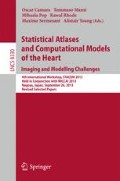Abstract
The here presented work is part of a CFD challenge investigating the potential for computational fluid dynamics (CFD) simulations to predicted pressures and flows in an aortic coarctation during stress when conditions for the rest case are known. In our approach, we choose to couple a three element Windkessel model to the outlet boundary conditions. Good reproducibility of flow and pressures for the rest case were achieved. In the stress case, where only the inflow boundary condition was changed, baseline pressure was too high, indicating that the total resistance in the Windkessel models may need to be reduced. This would correspond to dilating the blood vessels as might be the result of a pharmacological stress test. Future work is needed to develop an optimization strategy to tune the Windkessel data for matching the clinical results.
Access this chapter
Tax calculation will be finalised at checkout
Purchases are for personal use only
Preview
Unable to display preview. Download preview PDF.
References
Shumacker Jr., H.B., Nahrwold, D.L., King, H., Waldhausen, J.A.: Coarctation of the aorta. Curr. Probl. Surg., 1–64 (February 1968)
Frydrychowicz, A., Markl, M., Hirtler, D., Harloff, A., Schlensak, C., Geiger, J., Stiller, B., Arnold, R.: “Aortic hemodynamics in patients with and without repair of aortic coarctation: in vivo analysis by 4D flow-sensitive magnetic resonance imaging. Invest Radiol. 46, 317–325 (2011)
Brown, A.G., Shi, Y., Marzo, A., Staicu, C., Valverde, I., Beerbaum, P., Lawford, P.V., Hose, D.R.: Accuracy vs. computational time: translating aor-tic simulations to the clinic. J. Biomech. 45, 516–523 (2012)
Taylor, C.A., Hughes, T.J., Zarins, C.K.: Finite element modeling of three-dimensional pulsatile flow in the abdominal aorta: relevance to athero-sclerosis. Ann. Biomed. Eng. 26, 975–987 (1998)
Taylor, C.A., Hughes, T.J., Zarins, C.K.: Effect of exercise on hemody-namic conditions in the abdominal aorta. J. Vasc. Surg. 29, 1077–1089 (1999)
Taylor, T.W., Yamaguchi, T.: Flow patterns in three-dimensional left ventricular systolic and diastolic flows determined from computational fluid dynamics. Biorheology 32, 61–71 (1995)
Castro, M., Putman, C., Radaelli, A., Frangi, A., Cebral, J.: Hemodynam-ics and rupture of terminal cerebral aneurysms. Acad. Radiol. 16, 1201–1207 (2009)
Cebral, J.R., Hendrickson, S., Putman, C.M.: Hemodynamics in a lethal basilar artery aneurysm just before its rupture. AJNR Am J. Neuroradiol. 30, 95–98 (2009)
Ford, M.D., Stuhne, G.R., Nikolov, H.N., Habets, D.F., Lownie, S.P., Holdsworth, D.W., Steinman, D.A.: Virtual angiography for visualization and validation of computational models of aneurysm hemodynamics. IEEE Trans. Med. Imaging 24, 1586–1592 (2005)
Jou, L.D., Wong, G., Dispensa, B., Lawton, M.T., Higashida, R.T., Young, W.L., Saloner, D.: Correlation between lumenal geometry changes and hemodynamics in fusiform intracranial aneurysms. AJNR Am. J. Neuroradiol. 26, 2357–2363 (2005)
Karmonik, C., Benndorf, G., Klucznik, R., Haykal, H., Strother, C.M.: Wall shear stress variations in basilar tip aneurysms investigated with computational fluid dynamics. In: Conf. Proc. IEEE Eng. Med. Biol. Soc., vol. 1, pp. 3214–3217 (2006)
Kleinstreuer, C., Li, Z.: Analysis and computer program for rupture-risk prediction of abdominal aortic aneurysms. Biomed Eng. Online 5, 19 (2006)
Kleinstreuer, C., Li, Z., Farber, M.A.: Fluid-structure interaction analyses of stented abdominal aortic aneurysms. Annu. Rev. Biomed. Eng. 9, 169–204 (2007)
Li, Z., Kleinstreuer, C.: Blood flow and structure interactions in a stented abdominal aortic aneurysm model. Med. Eng. Phys. 27, 369–382 (2005)
Karmonik, C., YJ., Spiegel, M., Redel, T., Mohammed, A., Horner, M., Kroeger, R., Grossman, R.G.: Effects of Inflow Variation in a Cerebral Aneu-rysm - An Image-based Approach for the Analysis of CFD Simulation Data. In: Asilomar Conference on Signals, Systems and Computers Asilomar, CA (2009)
Karmonik, C., Klucznik, R., Benndorf, G.: Blood flow in cerebral aneu-rysms: comparison of phase contrast magnetic resonance and computational fluid dynamics–preliminary experience. Rofo 180, 209–215 (2008)
Acevedo-Bolton, G., Jou, L.D., Dispensa, B.P., Lawton, M.T., Higa-shida, R.T., Martin, A.J., Young, W.L., Saloner, D.: Estimating the hemodynamic impact of interventional treatments of aneurysms: numerical simulation with experimental validation: technical case report. Neurosurgery, vol. 59, pp. E429-E430; author reply E429-E430 (August 2006)
Author information
Authors and Affiliations
Editor information
Editors and Affiliations
Rights and permissions
Copyright information
© 2014 Springer-Verlag Berlin Heidelberg
About this paper
Cite this paper
Karmonik, C., Brown, A., Debus, K., Bismuth, J., Lumsden, A.B. (2014). CFD Challenge: Predicting Patient-Specific Hemodynamics at Rest and Stress through an Aortic Coarctation. In: Camara, O., Mansi, T., Pop, M., Rhode, K., Sermesant, M., Young, A. (eds) Statistical Atlases and Computational Models of the Heart. Imaging and Modelling Challenges. STACOM 2013. Lecture Notes in Computer Science, vol 8330. Springer, Berlin, Heidelberg. https://doi.org/10.1007/978-3-642-54268-8_11
Download citation
DOI: https://doi.org/10.1007/978-3-642-54268-8_11
Publisher Name: Springer, Berlin, Heidelberg
Print ISBN: 978-3-642-54267-1
Online ISBN: 978-3-642-54268-8
eBook Packages: Computer ScienceComputer Science (R0)

